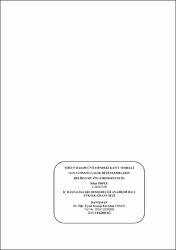| dc.contributor.author | Topçu, Nihal | |
| dc.date.accessioned | 2020-01-07T07:30:27Z | |
| dc.date.available | 2020-01-07T07:30:27Z | |
| dc.date.issued | 2019 | |
| dc.identifier.uri | https://hdl.handle.net/20.500.11776/3381 | |
| dc.description.abstract | Deliryum yüksek morbidite, mortalite oranları ve tedavi maliyeti artışı ile ilişkili olup, görülme sıklığı yoğun bakım ünitelerinde (YBÜ) daha fazladır. Bu araştırmada, YBÜ’de non-farmakolojik düzenlemelerin deliryum gelişimine etkisini değerlendirmek amaçlanmıştır. Çalışmamız Haziran 2017-Ocak 2018 tarihleri arasında, dahiliye YBÜ'de yürütülmüştür. Veriler Hasta Tanılama Formu, APACHE II, Glasgow Koma Skalası, Richmond Sedasyon-Ajitasyon Skalası, Yoğun Bakım Ünitesinde Konfüzyon Değerlendirme Ölçeği, Richard-Campbell Uyku Ölçeği ve Günlük İzlem Formu kullanılarak hastaların izlenmesi ile elde edilmiştir. Ayrıca eş zamanlı olarak YBÜ’de gürültü düzeyinin sürekli ölçümleri sağlanmıştır. Araştırma örneklemini, araştırmaya katılmayı kabul eden,YBÜ’de en az 24 saat kalmış, Glasgow Koma Skalası puanı ?10 ve RASS -3 ve üzeri puan almış, iletişim kurulabilen toplam 78 hasta oluşturmuştur. YBÜ rutinlerinde hiçbir değişiklik yapılmaksızın kontrol grubu verileri elde edilmiştir. Aynı değerlendirme formları "Yoğun Bakımda Analjezi, Sedasyon ve Deliryum Yönetimi için Kanıt ve Görüş Temelli Rehber (2015)" de yayınlanan ışık ve gürültü azaltmaya yönelik non-farmakolojik önlemler alınarak yeni hasta grubunda tekrar uygulanmıştır. Çalışmamıza katılan hastaların yaş ortalaması 70,01±13,18’dir. Çalışmamızda deliryum görülme sıklığı; kontrol grubunda yer alan hastalarda %60, müdahale grubunda yer alan hastalarda %44,7 olarak hesaplanmıştır (p>0,05). Alınan önlemler sonrası, YBÜ ortalama gürültü seviyesi 70,89±3,81 dB(A)’den 62,66±3,45 dB(A)’e gerilemiş (p<0,01), Richard-Campbell Uyku Ölçeği puan ortalaması 48,29±1,39’den 62,05±1,81’e yükselmiştir (p<0,01). Araştırmadan elde edilen sonuçlar doğrultusunda deliryum görülme oranlarının azaldığı ve gürültü seviyesindeki azalmanın hastanın uyku kalitesini pozitif yönde etkilediği saptanmıştır. Düzenlemelerin etkinliğinin daha iyi gösterilmesi için daha geniş örneklem gruplarında araştırmanın tekrarlanması önerilmektedir | en_US |
| dc.description.abstract | Delirium is associated with high morbidity, mortality rates and increased treatment costs, and the incidence is higher in Intensive Care Units ICU. In this study, the aim was to evaluate the effect of non-pharmacological regulations in the ICU on delirium development. This study was conducted between June 2017 and January 2018 in an internal diseases ICU. Data was collected through the monitoring of patients with the use of a Patient Identification Form, the APACHE II, the Glasgow Coma Scale, the Richmond Sedation-Agitation Scale, the Intensive Care Unit Confusion Evaluation Scale, the Richard-Campbell Sleep Scale, and a Daily Monitoring Form. Additionally, noise was continuously and simultaneously measured in the ICU. The sample consisted of a 78 patients who agreed to participate in the study, who had been staying at the ICU for at least 24 hours, who scored ?10 from the Glasgow Coma Scale and ?-3 from the RASS and who were capable of communicate. The data from the control group was obtained without any changes to ICU routines. The same evaluation forms were applied to the study group by taking the non-pharmacological precautions to reduce noise and light published in the “Evidence and Consensus Based Guideline for the Management of Analgesia, Sedation and Delirium in Intensive Care”. The mean age of the patients was 70,01±13,18 years. The incidence of delirium in our study was calculated to be 60% in the patients in the control group and 44.7% in the patients in the intervention group (p>0.05). After the precautions the mean noise level in the ICU decreased from 70,89±3,81 dB(A) to 62,66±3,45 dB(A) (p<0,01). The mean Richard-Campbell Sleep Scale score increased from 48,29±1,39 to 62,05±1,81 (p<0.01). According to our results, was found that the rate of delirium decreased and the decreases in the noıse levels positively affected the sleep quality of patients In order to show the effectiveness of the regulations better, it is suggested that the study should be repeated with wider sample groups. | en_US |
| dc.language.iso | tur | en_US |
| dc.publisher | Namık Kemal Üniversitesi | en_US |
| dc.rights | info:eu-repo/semantics/embargoedAccess | en_US |
| dc.subject | Deliryum | en_US |
| dc.subject | Yoğun Bakım Ünitesi | en_US |
| dc.subject | Uyku Kalitesi | en_US |
| dc.subject | Gürültü | en_US |
| dc.subject | Hemşirelik | en_US |
| dc.subject | Delirium | en_US |
| dc.subject | Intensive Care Unit | en_US |
| dc.subject | Sleep Quality | en_US |
| dc.subject | Noise | en_US |
| dc.subject | Nursing | en_US |
| dc.title | Yoğun bakım ünitesindeki kanıt temelli non-farmakolojik düzenlemelerin deliryumu önlemedeki etkisi | en_US |
| dc.title.alternative | The Effect of Evidence Based Non-Pharmacological Regulations in The İntensive Care Unit on Preventing Delirium | en_US |
| dc.type | masterThesis | en_US |
| dc.department | Enstitüler, Sağlık Bilimleri Enstitüsü, İç Hastalıkları Hemşireliği Ana Bilim Dalı | en_US |
| dc.relation.publicationcategory | Tez | en_US |



















